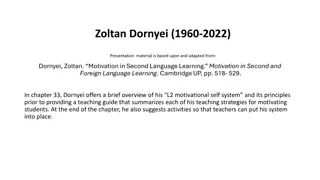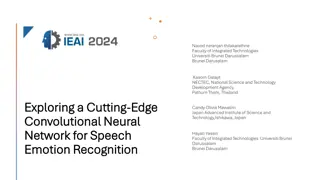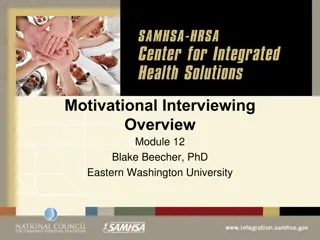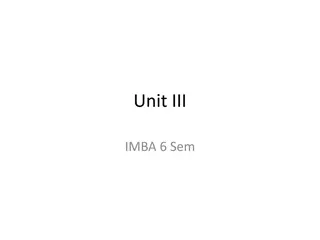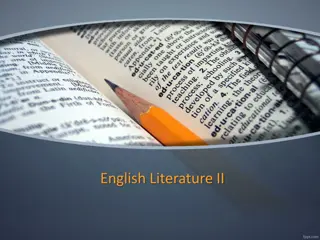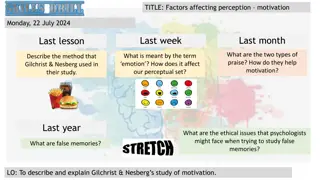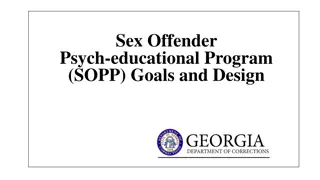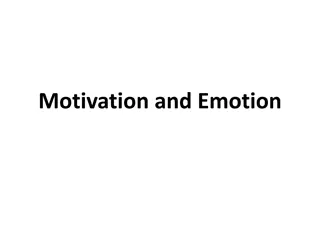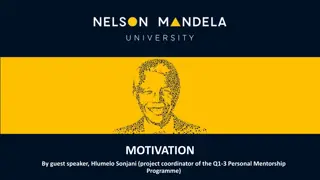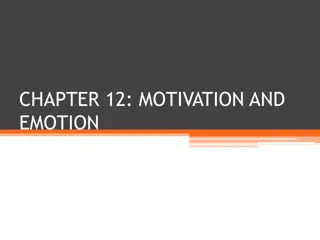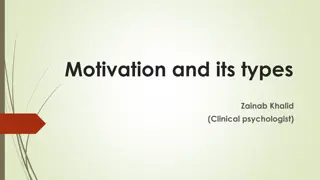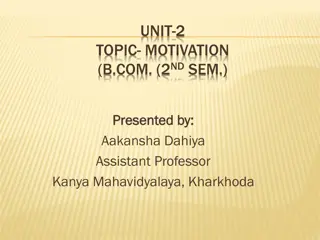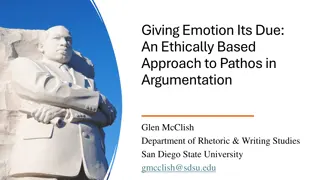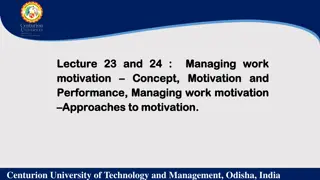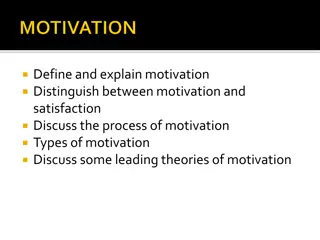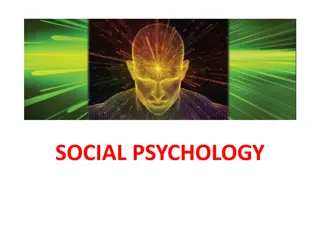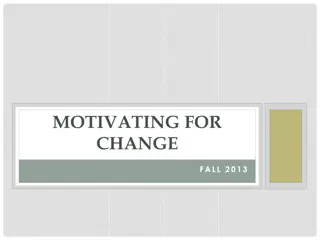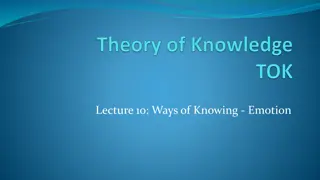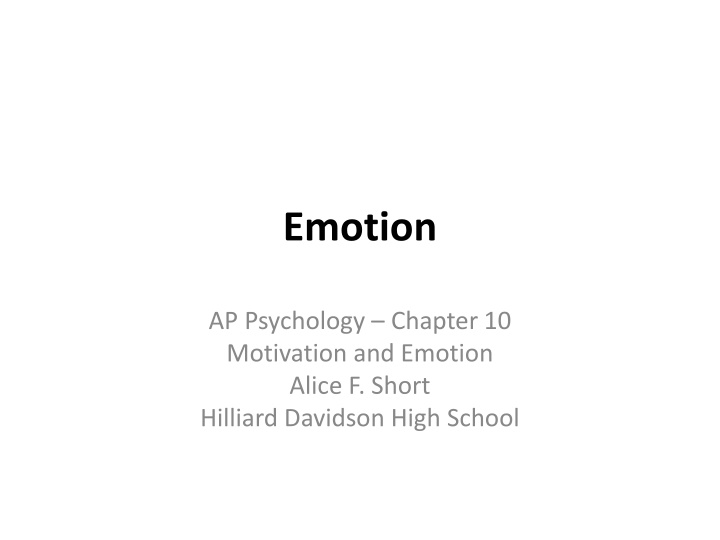
Motivation, Emotion, and Hunger: Insights from AP Psychology
Explore the fascinating realms of motivation, emotion, and hunger through the lens of AP Psychology. Delve into theories of motivation, the biology of hunger, and the intricate interplay between physiological signals and behaviors. Unravel the complexities of drive reduction theory, optimum arousal theory, and the biology behind hunger cues. Gain a deeper understanding of how these factors influence human behavior and well-being.
Download Presentation

Please find below an Image/Link to download the presentation.
The content on the website is provided AS IS for your information and personal use only. It may not be sold, licensed, or shared on other websites without obtaining consent from the author. If you encounter any issues during the download, it is possible that the publisher has removed the file from their server.
You are allowed to download the files provided on this website for personal or commercial use, subject to the condition that they are used lawfully. All files are the property of their respective owners.
The content on the website is provided AS IS for your information and personal use only. It may not be sold, licensed, or shared on other websites without obtaining consent from the author.
E N D
Presentation Transcript
Emotion AP Psychology Chapter 10 Motivation and Emotion Alice F. Short Hilliard Davidson High School
Chapter Preview Theories of Motivation Hunger, Obesity, and Eating Disorders Motivation in Everyday Life Emotion Pursuit of Happiness
Motivation motivation - the force that moves people to behave, think, and feel as they do energizes, directs, and sustains behavior
Theories of Motivation Evolutionary Approach ethology the study of animal behavior instincts sign stimulus something in the environment that turns on a fixed pattern of behavior explains motivations for sex, aggression and achievement Drive Reduction Theory drive reduction theory as a drive becomes stronger, we are motivated to reduce it (drives, needs, and homeostasis) drive is an aroused state that occurs because of a physiological need (itch to scratch) need a deprivation that energizes the drive to eliminate or reduce the deprivation homeostasis the body s tendency to maintain an equilibrium, or steady state examples: temperature, blood sugar, potassium and sodium levels and oxygenation DISCUSSION: Why is drive reduction theory not a comprehensive explanation of motivation? Optimum Arousal Theory Yerkes-Dodson law performance is best under conditions of moderate arousal rather than either low or high arousal overlearning learning to perform a task so well that it becomes automatic DISCUSSION: How can overlearning help your academic performance in AP Psychology and other courses? When might it be really important to have overlearning?
Biology of Hunger Gastric signals Walter Cannon and A.L. Washburn RESEARCH: connection b/w stomach contractions and hunger cholecystokinin (CCK) hormone that starts the digestion of food , travels to the brain through the bloodstream, and signals us to stop eating Blood chemistry glucose (blood sugar) insulin (hormone, helps control blood sugar levels) leptin (chemical substance released by fat cells, decreases food intake and increases energy expenditure or metabolism) ob mice obsese mice, genetic mutation, cannot produce leptin
Hunger and the Brain Hypothalamus lateral hypothalamus initiation of hunger and eating damage: starving animal won t eat ventromedial hypothalamus cessation of hunger and eating damage: eating too much and quick onset of obesity Neurotransmitters
Obesity and Eating Behavior Obesity is widespread 60% of Americans are overweight 33% of Americans are obese Biology of Overeating genetics set point weight maintained when the individual makes no effort to gain or lose weight fat (adipose) cells normal weight: 10-20 billion obese person: up to 100 billion Psychological Factors In the past, the focus was on emotional state external food cues Current research is focusing on time and place cues sugar and fat content
Disordered Eating: Anorexia Nervosa Anorexia Nervosa relentless pursuit of thinness through starvation more common among females, non-Latino, and middle- and upper- classes associated with high-achieving perfectionists associated with obsessive thinking about with and compulsive exercise typically begins in teenage years main characteristics less than 85% of normal weight unsupported fear of gaining weight distorted body image amenorrhea medical dangers and mortality highest mortality rate of any psychological disorder 5.6% die within 10 years of diagnosis growth of tine hair all over the body, thinning of bones and hair, severe constipation, low blood pressure
Disordered Eating: Bulimia Nervosa Bulimia Nervosa binge-and-purge vomiting, laxatives more common among females (1-4 percent) typically in a person of a normal weight difficult to detect why? preoccupied with food fearful, depressed, anxious, shame low self-efficacy (high standards, low confidence) associated with impulsivity, negative emotions and childhood obsessive-compulsive disorder medical dangers
Disordered Eating: Causes Causes of Anorexia and Bulimia sociocultural media images family interactions TRAILER: MissRepresentation biological genetics serotonin regulation neurological effects of dieting, binging, purging
Disordered Eating: Binge Eating Disorder Binge Eating Disorder recurrent episodes of compulsively eating large amounts of food despite not being hungry, eat quickly to point of discomfort lack of control over eating 2-5% of Americans will experience at some point in life 8% of the obese have BED causes include biological factors (genetics, dopamine, stress)
Maslows Hierarchy of Needs sequence of needs basic needs must be met before higher needs can be satisfied self-actualization (motivation to develop to our fullest potential)
Self-Determination Theory self-determination theory Edward Deci and Richard Ryan s theory asserting that all humans have three basic, innate organismic (psychological needs are innate and exist in every person) needs Three Basic Organismic Needs: competence self-efficacy, mastery, expectations for success self-efficacy belief that you have the competence to accomplish a given goal or task mastery the sense that you can gain skills and overcome obstacles relatedness warm relations with others, need to belong even unintentional exclusion can cause stress and poor life choices autonomy independence and self-reliance Kennon Sheldon (2005) older Americans feel more autonomous when engaging in same behaviors (voting, etc.)
Intrinsic vs. Extrinsic Motivation Intrinsic Motivation motivation based on internal factors organismic needs (competence, relatedness, and autonomy) + enjoyability (curiosity, challenge and fun) key to achievement Extrinsic Motivation motivation that involves external incentives incentives (rewards, punishments) associated with lowered well-being and health both individualist and collectivist cultures support self- determination theory
A SHORT Time to Ponder CRITICAL CONTROVERSY: Does extrinsic motivation undermine intrinsic motivation? (p. 327) What are some instances in your own life in which your intrinsic motivation was reduced by external rewards? What are some instances in which your intrinsic motivation was increased by external rewards? What other factors might determine whether extrinsic motivation influences intrinsic motivation?
Self-Regulation self-regulation - the process by which an organism controls behavior in order to pursue important objectives feedback = important component (example: daily mood) cannot be happy all the time require negative feedback goals, a.k.a. projects, best possible selves, life tasks, personal strivings purpose an intention to accomplish a goal that is meaningful to oneself and t o contribute something to the world Goal Setting specific moderately challenging long term purpose short term accomplishment high-achieving individuals: monitor learning and systematically evaluate their progress toward their goals
A SHORT Activity Create some goals, and write them in your spiral. Be sure to use the techniques for successful goal- setting! It might be nice if they contained some purpose as well. purpose an intention to accomplish a goal that is meaningful to oneself and to contribute something to the world goal setting specific moderately challenging long term purpose short term accomplishment
INTERSECTION: Resisting Temptation p. 328 Delay of Gratification Walter Mischel kids and cookies putting off pleasurable experience knowing there will be future payoff distraction helps us resist temptation DISCUSSION: What are some of the cookies in your life? How do you avoid being sidetracked by temptation?
Emotion emotion - a feeling, or affect, that can involve physiological arousal (such as a fast heartbeat), conscious experience (thinking about being in love with someone), and behavioral expression (a smile or a grimace) physiological arousal Autonomic Nervous System Sympathetic Nervous System arouses Parasympathetic Nervous System calms
The Two Main Divisions of the Nervous System: Nervous System: Divisions 1. Central Nervous System (CNS) brain and spinal cord 2. Peripheral Nervous System (PNS) somatic nervous system sensory nerves muscular activity autonomic nervous system internal organs sympathetic nervous system arouses parasympathetic nervous system calms
Autonomic Nervous System
A SHORT Assignment Look back at the table on the previous slide. Write a short narrative that includes as much of the vocabulary as possible, referencing specifically if it relates to the parasympathetic or sympathetic nervous system.
Measuring Arousal skin conductance level (SCL) a rise in the skin s electrical conductivity when sweat gland activity increases sweaty palms conduct electricity better polygraph a machine, commonly called a lie detector, that monitors changes in the body used to try to determine whether someone is lying heart rate, breathing, SCL neutral v. target questions results do not reliably detect deception Employee Polygraph Protection Act (1988) fMRI may better detect deception
Theories of Emotion James-Lange Theory - the theory that emotion results from physiological states triggered by stimuli in the environment William James and Carl Lange ( Long-uh ) physiological arousal emotion perception of physiological changes bull example: you do not run away because you are afraid you are afraid because you are running way Cannon-Bard Theory Walter Cannon (1927) Philip Bard (1934) objected to James- Lange Theory bull example: first, it stimulates your autonomic nervous system to produce physiological changes in emotion (increased heart rate; rapid breathing) second, it sends messages to your cerebral cortex, where the experience of emotion is perceived emotional and physiological reactions occur simultaneously
Theories of Emotion
Emotion and the Brain Limbic System: Amygdala fear system: two pathways thalamus amygdala sensory cortex persistence of emotional memories Cerebral Hemispheres left hemisphere: approach-related emotions right hemisphere: withdrawal-related emotions
direct pathway (broken arrow) conveys information rapidly from the thalamus to the amygdala indirect pathway (solid arrows) transmits information more slowly from the thalamus to the sensory cortex (here the visual cortex) and then to the amygdala Brain Pathways of Fear (Fig. 10.6)
Emotion: Cognitive Factors Two-Factor Theory (Schachter/Singer) physiological arousal cognitive labeling arousal interpret external cues label emotion
Research, Schachter and Singer (1962): injected with epinephrine (heightens arousal) associate behavior with others emotions Two-Factor Theory of Emotion
Donald Dutton and Arthur Aron (1974) Capilano River Bridge Experiment: Misinterpreted Arousal Intensifies Emotional Experiences (Fig. 10.8, p. 334)
A SHORT Time to Ponder Do you think you can choose to interpret arousal in more productive and positive ways? Explain.
Emotion: Factors Emotion is a feeling, or affect, that can involve physiological arousal, conscious experience, and behavioral expression. The Primacy Debate: Cognition or Emotion Which comes first - feeling or thinking? Lazarus: appraisal determines feelings (thinking is primary) Zajonc: preferences need no inferences (emotions are primary) Behavioral Factors verbal or nonverbal nonverbal - facial expression, posture, gestures
A SHORT Time to Ponder? Which whom do you agree on the primacy debate, Lazarus or Zajonc?
Emotion: Behavioral Factors Identifying Facial Expressions happiness, anger, sadness, surprise, disgust, fear Facial Feedback Hypothesis facial expression can influence emotions supports the James-Lange theory of emotions
Can you correctly identify the emotions? Identifying Emotions
Emotion: Sociocultural Factors Comparative Perspectives expression of emotions similar across cultures display rules sociocultural standards that determine when, where, and how emotions should be expressed anger ok, not ok to express? no universal gestures Computer Communication Scott Fahlman (1982) emoticons compensation for loss of other expressive channels (tone, facial expression, etc.) vary between cultures Gender Influences stereotypes
Classifying Emotions Valence (direction) positive v. negative affect Arousal Level (degree) active and engaged v. passive and calm Positive Negative High Ecstasy Fury Low Contentment Boredom
Circumplex Model of Mood Psychological Inquiry, p. 339
Adaptive Function of Emotions Negative Emotions take immediate corrective action Positive Emotions broaden-and-build model Fredrickson s model of positive emotion, stating that the function of positive emotions lies in their effects on an individual s attention and ability to build resources broadens attention focus more likely to think outside-the-box, to exercise, to make friends, to branch out encourages approach behavior Resilience positive outlook emotional wisdom better response to stress
Pursuit of Happiness Biological Factors genetics set point Obstacles hedonic treadmill - direct pursuit can backfire Happiness Activities & Goal Striving altruism, physical activity, positive self-reflection personally meaningful goal investment
A SHORT Time to Ponder Do you lack resources or resourcefulness?
Chapter Summary Describe the evolutionary, drive reduction, and optimum arousal theories of motivation. Explain the physiological basis of hunger and the nature of eating behavior. Distinguish the competing theories of emotion. Characterize the range of factors affecting emotions. Classify emotions.
Chapter Summary Theories of Motivation drive reduction and optimum arousal theories Hunger biological and psychological influences obesity and eating disorders Non-Biological Theories of Motivation Maslow s hierarchy self-determination and self regulation intrinsic v. extrinsic motivations
Chapter Summary Emotion physiological arousal James-Lange, Cannon-Bard, and two-factor theory nonverbal expression sociocultural factors classifying emotion Pursuit of Happiness

